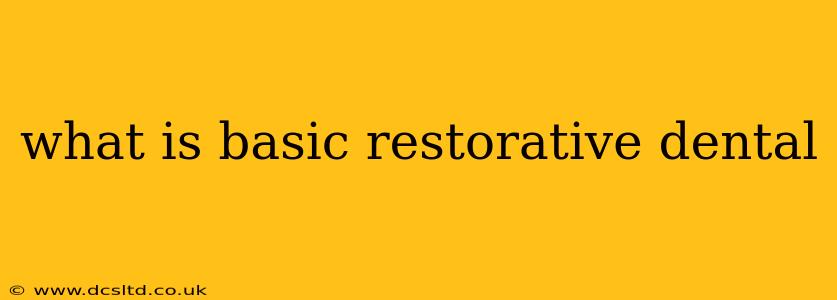Basic restorative dentistry encompasses the procedures dentists perform to repair damaged or decayed teeth, restoring both their function and aesthetics. It focuses on addressing issues like cavities, chipped teeth, and minor structural problems, aiming to preserve natural teeth for as long as possible. This branch of dentistry plays a crucial role in maintaining oral health and preventing more extensive dental work down the line.
This guide will explore the key aspects of basic restorative dentistry, answering common questions and providing a comprehensive understanding of the procedures involved.
What are the common procedures in basic restorative dentistry?
Basic restorative dentistry primarily involves these common procedures:
-
Dental Fillings: These are used to repair cavities (tooth decay) by removing the decayed portion and filling the resulting hole with a suitable material. Common filling materials include composite resin (tooth-colored), amalgam (silver), and gold. The choice of material depends on various factors, including the location and size of the cavity, the patient's preferences, and the dentist's recommendations.
-
Dental Crowns: Crowns are tooth-shaped caps that completely cover a damaged tooth, protecting it from further decay or fracture. They're often used for teeth with large fillings, significant decay, or those that have undergone root canal treatment. Crowns can be made from various materials, including porcelain, metal, or a combination of both.
-
Dental Inlays and Onlays: These are indirect restorations, meaning they are made in a dental lab and cemented onto the tooth. Inlays cover the chewing surface of the tooth, while onlays extend beyond the cusp (point) of the tooth. They are stronger than fillings and offer a more conservative approach than a full crown.
-
Dental Bonding: This procedure uses a tooth-colored composite resin to repair chipped, cracked, or discolored teeth. It's a less invasive and often more affordable alternative to crowns or veneers for minor cosmetic issues.
-
Extractions: In cases where a tooth is severely damaged beyond repair or needs to be removed for orthodontic reasons (e.g., to make space for other teeth), extraction is necessary. This involves surgically removing the tooth from its socket. Modern techniques minimize discomfort and facilitate faster healing.
What are the benefits of basic restorative dentistry?
The benefits extend beyond simply repairing damaged teeth. Basic restorative dentistry helps:
-
Prevent further decay: Addressing cavities early prevents the spread of decay to other areas of the tooth or adjacent teeth.
-
Preserve natural teeth: Restorative procedures aim to save natural teeth, avoiding the need for more extensive treatments like implants or dentures.
-
Improve chewing function: Damaged or missing teeth can impact chewing ability. Restorative work restores proper chewing function, improving digestion and overall health.
-
Enhance aesthetics: Restorative dentistry can significantly improve the appearance of your smile by addressing discoloration, chips, cracks, and gaps.
-
Boost self-confidence: A healthy and beautiful smile can boost self-esteem and confidence.
What kind of preparation is needed before basic restorative procedures?
Preparation typically involves:
-
Initial examination and diagnosis: The dentist will assess your oral health, diagnose the problem, and discuss the best treatment options. X-rays may be taken to examine the extent of the damage.
-
Cleaning: Your teeth will be professionally cleaned to remove plaque and tartar before the procedure.
-
Anesthesia: Local anesthesia is commonly used to numb the area, ensuring your comfort during the procedure.
-
Post-procedure care instructions: Your dentist will provide detailed instructions for aftercare to ensure proper healing and prevent complications.
How long does it take to complete basic restorative dental work?
The duration of treatment varies depending on the complexity of the procedure. A simple filling might take 30-60 minutes, while a crown might require multiple appointments over several weeks due to the lab work involved. Your dentist will provide a realistic timeline during your initial consultation.
What are the costs associated with basic restorative dentistry?
Costs vary widely depending on the procedure, materials used, and your location. Insurance coverage can significantly impact the final cost. It's essential to discuss fees and payment options with your dentist upfront.
How can I find a qualified restorative dentist?
Look for a dentist with experience and expertise in restorative dentistry. You can ask for referrals from friends or family, check online reviews, or contact your dental insurance provider for a list of network dentists. It's important to feel comfortable and confident in your dentist's abilities.
By understanding the scope of basic restorative dentistry and its benefits, you can make informed decisions about your oral health and maintain a healthy, beautiful smile for years to come. Remember, regular dental check-ups and preventative care are key to minimizing the need for extensive restorative work.
